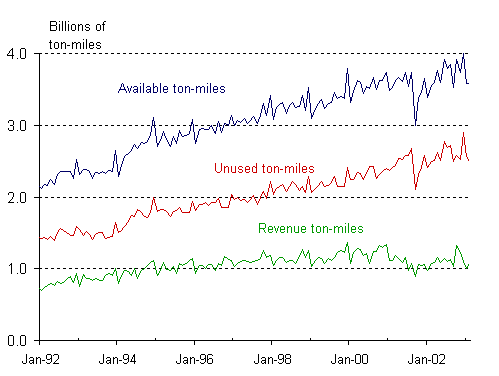Domestic Flights: Air Freight
Domestic Air Freight Ton-Miles (monthly data, not seasonally adjusted)
Excel |
CSV |
Table Version

Though still much smaller than air passenger transportation, air freight is an
increasingly important revenue source for the air transportation industry. It includes
both freight handled by dedicated air cargo handlers and air cargo shipped on combined
passenger and air freight carriers (passenger luggage is not considered cargo for this
purpose).
Unused ton-miles are the difference between available ton-miles and revenue ton-miles utilized. Changes in the level of spare capacity might be an indicator of the timely availability of air freight services. For example, a shipper with a sudden need for service will be more likely to obtain an appropriate flight when spare capacity is higher. Space limitations also affect the availability of air freight services.
| Available ton-miles (billions) |
3.77 |
3.83 |
| Percent change from same month previous year |
2.72 |
1.59 |
| Unused ton-miles (billions) |
2.62 |
2.73 |
| Percent change from same month previous year |
3.56 |
4.20 |
| Revenue ton-miles (billions) |
1.15 |
1.09 |
| Percent change from same month previous year |
0.88 |
-5.22 |
NOTES: The current value is compared to the value from the same period in the previous year to account for seasonality.
A revenue ton-mile is equal to one ton carried one mile and measures utilization of air-freight services. The data include both transborder and foreign flights by large U.S. carriers, but not include any flights by foreign carriers.
For those planes that carry both freight and passengers, available freight ton-miles are calculated by subtracting available seat-miles times 0.1 from total available ton-miles. The data have been adjusted to have a standard 30-day month by multiplying the data for each month by the ratio: 30/(actual days in month). These indicators are components of freight and overall aircraft load factors displayed in “Aircraft Capacity Utilization—Passengers and Freight.”
The dramatic changes in the September 2001 data reflect the impact of the terrorist attacks on Sept. 11, 2001, on aviation, including several days in which commercial air operations were suspended.
The data reported here excludes small-certificated and commuter carriers that began reporting T100 data in 2002 for comparability with previous issue.
Refer to the Special Notes at http://www.bts.gov/oai/ for special concerns regarding the preliminary nature of the most recent data for latest issue of Air Carriers Traffic Statistics Monthly.
SOURCE: U.S. Department of Transportation, Bureau of Transportation Statistics, Air Carrier Traffic Statistics Monthly, April 2003.
|

